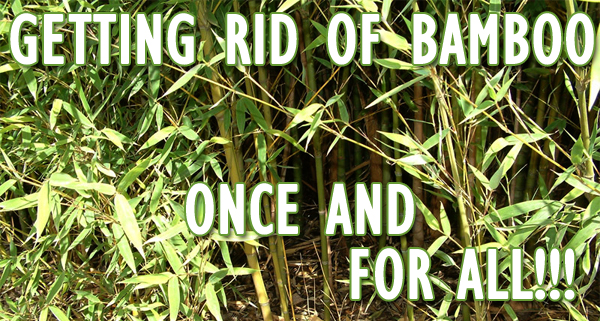Getting rid of Bamboo

If you are one of the many gardeners who have planted bamboo in your yard only to regret it later, then you have no doubt spent countless nights dreaming of many fantastic ways to kill bamboo. Subsequently, you've also found that none of them work. If you are one of the unlucky neighbors who have Running Bamboo creeping onto your property, then maybe the bamboo is not the only thing you have spent your nights dreaming of killing.
There are two major types of bamboo. The first type is called Running Bamboo. Running Bamboo gets this name because the rhizomes spread out quickly and will create a wall of bamboo in a short time. Running Bamboo is the most hated type of bamboo, but it is also the most effective if you want to create a privacy wall. Clumping Bamboo stays in a tighter clump and grows more slowly than does Running Bamboo. Just remember that Clumping Bamboo can be just as difficult to kill.
The truth is bamboo is one of the most difficult plants to get rid off. You can mow it down but you will only delay your problem since it will undoubtedly come back to haunt you later. You can dig it all completely out (laughing heartily), but any part of the plant still in the soil (the Rhizomes) will begin to reproduce. Similarly, if you chose to spray herbicide to kill the bamboo it will only kill the shoots not the roots.
So, what's the answer? When people call my radio show and ask how to get rid of bamboo, I first tell them "You're not going to like the answer, but it does work." Essentially you have to suffocate the area. With no air, water, sunshine, etc., etc., the plant can be controlled. However, if the bamboo is growing on the other side of the fence (You remember the ticked-off neighbor don't you?) you also have to perform this task over there, or it will come roaring back.
Whatever method you use to eradicate bamboo, always remember that cutting below the soil line is the most important step in this process. You can use axes, loppers, hand shears or whatever, just make sure you're cutting below the soil line. Every cane must go. Then, use a thick piece of plastic or a dark tarp and cover every square inch of area you just cut down. You must also anchor that thick plastic or tarp down. Some people use cinder blocks; others anchor it with bent pieces of metal or steel. The key here is to make sure the plastic never moves so that you are depriving the area of all that air, water and sunshine.
You may get new growth popping up from the side and when that happens you have to immediately do one of two things. You can spray anything green with a brush killer herbicide, namely any product with the active ingredient Triclopyr, or you can cut it down below the ground again and cover that area up with something like a brick or another cinder block etc.
Some of you may be asking, "Randy, if the brush killer herbicide works on the new growth, why don't I just spray it on all the bamboo?" because it won't kill it down to the roots if the canes are well developed. The only way a herbicide would actually work on bamboo is if you physically got in and opened up the bamboo from the top, punctured each and every cane's layers and poured the herbicide (undiluted) to the bottom of the cane as if you were filling a straw. If you have a thick stand of bamboo, do I need to tell you what a remarkably tedious process that would be?
Others may be asking another obvious question like "Randy, if I can cut it down or kind of dig it up, why not just bring in a backhoe and dig out the entire area, rhizomes and all. Okay, you can try that, but I think you'll be shocked how many parts of the plant/rhizome are still there, and can start reproducing in a matter of days. Plus, the average homeowner doesn't have ready access to a backhoe, now do they?
Lastly, remember that most of this discussion is centered on Running Bamboo varieties. There are Clumping varieties that are far less invasive, but still capable of growing prolifically to the point that, as noted earlier, all the same control methods listed above are necessary on Clumping varieties as well.
|
 |
| |
| Randy Lemmon is the host of the GardenLine radio program on Newsradio 740 KTRH. Randy has been doing GardenLine in one capacity or another since December of 1995, for all three of the now Clear Channel AM stations - KTRH, KPRC & KBME. When Randy took over GardenLine, he replaced long-time Houston radio veteran and GardenLine originator, Bill Zak. For those who remember that far back, GardenLine was a weekly radio staple on KTRH from 10 a.m. to Noon Mondays through Fridays - along with a Saturday show as well. Now GardenLine is heard exclusively on Newsradio 740 KTRH on weekend mornings. |
|